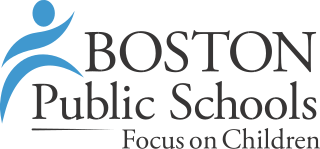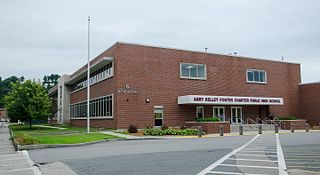
Secondary education is the last six or seven years of statutory formal education in the United States. It culminates with twelfth grade. Whether it begins with sixth grade or seventh grade varies by state and sometimes by school district.
Apponequet Regional High School, located at 100 Howland Road in Lakeville, Massachusetts opened September 21, 1959. Apponequet serves secondary academic education students from the towns of Freetown, and Lakeville. It is the only high school within the Freetown-Lakeville Regional School District.

Prospect Hill Academy Charter School (PHA) is college preparatory charter public school serving grades PreK - 12 in Somerville, Massachusetts and Cambridge, Massachusetts. The school was founded in 1996.
The Massachusetts Comprehensive Assessment system, commonly abbreviated as MCAS, is Massachusetts's statewide standards-based assessment program developed in 1993 in response to the Massachusetts Education Reform Act of the same year. State and federal law mandates that all students who are enrolled in the tested grades and who are educated with Massachusetts public funds participate in MCAS testing.
Adequate Yearly Progress (AYP) was a measurement defined by the United States federal No Child Left Behind Act that allowed the U.S. Department of Education to determine how every public school and school district in the country was performing academically according to results on standardized tests. As defined by National Council on Measurement in Education (NCME), AYP was "the amount of annual achievement growth to be expected by students in a particular school, district, or state in the U.S. federal accountability system, No Child Left Behind (NCLB)." AYP has been identified as one of the sources of controversy surrounding George W. Bush administration's Elementary and Secondary Education Act. Private schools were not required to make AYP.
The New Jersey Assessment of Skills and Knowledge (NJASK) was a standardized test given to all New Jersey public-schooled students in grades 3-8 during (usually) March, April, or May, and was administered by the New Jersey Department of Education.
The Minnesota Graduation Standards, also known as the Profile of Learning and the Minnesota Academic Standards, created in 1998, were intended to raise standards of education for Minnesota high school students. The Minnesota Graduation Standards were developed to ensure minimum competence in survival skills for all Minnesota graduates from high school. The standards included two parts: the Minnesota Statewide Assessments and the Minnesota Academic Standards.

Boston Public Schools (BPS) is a school district serving the city of Boston, Massachusetts, United States. It is the largest public school district in the state of Massachusetts.
Education in Missouri is provided by both public and private schools, colleges, and universities, and a variety of public library systems. All public education in the state is governed by the Missouri State Board of Education, which is made up of eight citizens appointed by the Governor of Missouri and confirmed by the Missouri Senate.

Abby Kelley Foster Charter Public School is a K–12 school located at 10 New Bond St., Worcester, Massachusetts, United States in former Heald Machine Company buildings. The school was founded in 1998.

Provincetown Public Schools, also known as Provincetown School District, or Provincetown IB Schools, is the school district of Provincetown, Massachusetts, serving grades Kindergarten through 8.
Medford Public Schools is a school district located in Medford, Massachusetts. The district has 9 schools in the city serving grades K-12. It is led by Superintendent Dr. Marice Edouard-Vincent. The main office is located at 489 Winthrop Street, within the High School/Vocational-Technical High School building.
Groton-Dunstable Regional School District is a school district in the US state of Massachusetts which serves the towns of Groton and Dunstable.
Charter schools operate with considerably more independence than traditional public schools. However, Massachusetts has two kinds of charter schools - Commonwealth Charters and Horace Mann Charters. Horace Mann charter schools differ from Commonwealth charter schools as they must be located within a school district. Both kinds of charter schools are free to structure their curriculum and school environment; for instance, many charter schools fit more instructional hours into a year by running longer school days and providing instruction on weekends and during the summer. Because few charter schools are unionized, they can hire and fire teachers and administrative staff without regard to the collectively bargained seniority and tenure provisions that constrain such decisions in most public schools. Although charter students made up only 2.9 percent of U.S. public school enrollment in 2008–2009, charter enrollment has grown rapidly and seems likely to accelerate in the near future. The growth of charter schools is an important component of the contemporary education reform movement's pursuit of accountability and flexibility in public education. Proponents see charter schools' freedom from regulation as a source of educational innovation, with the added benefit of providing a source of competition that may prompt innovation and improvement in the rest of the public system. At the same time, charter schools are controversial because, after a transition period in which the state provides subsidies, they receive a tuition payment for each enrolled student paid by students' home districts. In Massachusetts, tuition payments are determined largely by the average per-pupil expenditure in sending districts. Not surprisingly, therefore, public school districts are concerned about the revenue lost when their students enroll in charter schools.
Medfield High School is a 9–12 public high school in Medfield, Massachusetts, part of Norfolk County, Massachusetts, United States. It is one of five public schools in the school system, and the only public high school in Medfield.
Wilbur Elementary School is a former elementary school located in Somerset, Massachusetts, United States. The school included kindergarten through fifth grade. It was involved with a state test scam which resulted in the invalidation of 74 test scores. In June 2014, the school closed permanently.

Westborough High School is a public high school in Westborough, Massachusetts, United States that serves as the high school for the Westborough Public School District. The school's mascot is the Ranger and the school colors are cardinal and navy blue. In the 2022–23 school year, WHS had an enrollment of 1178 students. The school is located in the downtown Westborough area at 90 West Main Street.
Founded in 2002, TechBoston Academy (TBA) is a pilot school located in Dorchester, Massachusetts, United States that offers a college preparatory curriculum to students in grades 6–12. TBA immerses its 1,050 students to a wide span of technological resources such as laptops, Smartboards, PDAs, digital cameras, Google Apps for Education, and podcasting. TBA offers advanced courses that utilize this technology and cover topics such as digital art, Adobe graphic design applications, computer programming, and E-commerce.

Lawrence High School is a public secondary school located in Lawrence, Massachusetts, United States. It is part of the Lawrence Public Schools. Its campus consists of several buildings and was completed in 2005.
The Graham and Parks School is a public elementary school in Cambridge, MA. Founded in 1981, the school was originally conceived as an "alternative school" aligned with the progressive education movement. It historically emphasized project-based learning, teacher-led curriculum development, and parent involvement in all aspects of school operation. Since the early 2000s, state curriculum guidelines and local policy changes have diminished these aspects of the school's identity, bringing it in line with city and state standards. The school is named for Rosa Parks and Saundra Graham, a welfare and housing advocate from Cambridge.







